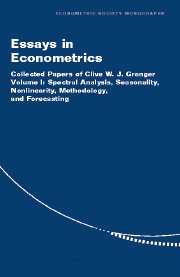Book contents
- Frontmatter
- Contents
- Acknowledgments
- List of Contributors
- Introduction
- 1 The ET Interview: Professor Clive Granger
- PART ONE SPECTRAL ANALYSIS
- PART TWO SEASONALITY
- 4 Seasonality: Causation, Interpretation and Implications
- 5 Is Seasonal Adjustment a Linear or Nonlinear Data-Filtering Process?
- PART THREE NONLINEARITY
- PART FOUR METHODOLOGY
- PART FIVE FORECASTING
- Index
4 - Seasonality: Causation, Interpretation and Implications
Published online by Cambridge University Press: 06 July 2010
- Frontmatter
- Contents
- Acknowledgments
- List of Contributors
- Introduction
- 1 The ET Interview: Professor Clive Granger
- PART ONE SPECTRAL ANALYSIS
- PART TWO SEASONALITY
- 4 Seasonality: Causation, Interpretation and Implications
- 5 Is Seasonal Adjustment a Linear or Nonlinear Data-Filtering Process?
- PART THREE NONLINEARITY
- PART FOUR METHODOLOGY
- PART FIVE FORECASTING
- Index
Summary
CAUSES OF SEASONALITY
It is a very well-known fact that many economic series display seasonality; that is, they have an observable component consisting of a fairly constant shape repeated every 12 months. This component is often treated as being so easily explained that neither an exact definition nor an explanation of its origins is required. It is the objective of this paper to suggest that ignoring consideration of causation can lead to imprecise or improper definitions of seasonality and consequently to misunderstanding of why series require seasonal adjustment, to improper criteria for a good method of adjustment and to have implications for the evaluation of the effects of adjustment both on a single series and when relating two or more series. These considerations do not necessarily lead to better practical methods of adjustment, but they should lead to a better understanding of how to interpret time series and econometric analysis involving seasonal components and seasonally adjusted series. The only other author, prior to this conference, who emphasizes causation of seasonals appears to be BarOn (1973).
There are at least four, not totally distinct, classes of causes of seasonal fluctuations in economic data. These classes are discussed in the following sections.
Calendar
The timing of certain public holidays, such as Christmas and Easter, clearly affects some series, particularly those related to production. Many series are recorded over calendar months, and, as the number of working days varies considerably from one month to another in a predetermined way, this will cause a seasonal movement in flow variables, such as imports or production.
Information
- Type
- Chapter
- Information
- Essays in EconometricsCollected Papers of Clive W. J. Granger, pp. 121 - 146Publisher: Cambridge University PressPrint publication year: 2001
Accessibility standard: Unknown
Why this information is here
This section outlines the accessibility features of this content - including support for screen readers, full keyboard navigation and high-contrast display options. This may not be relevant for you.Accessibility Information
- 5
- Cited by
